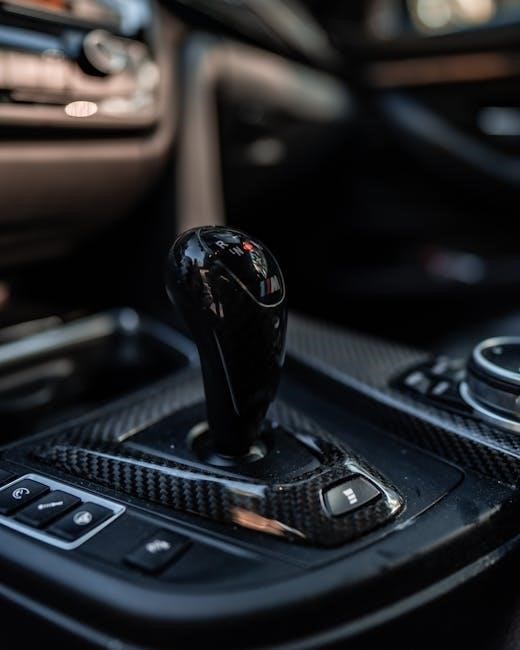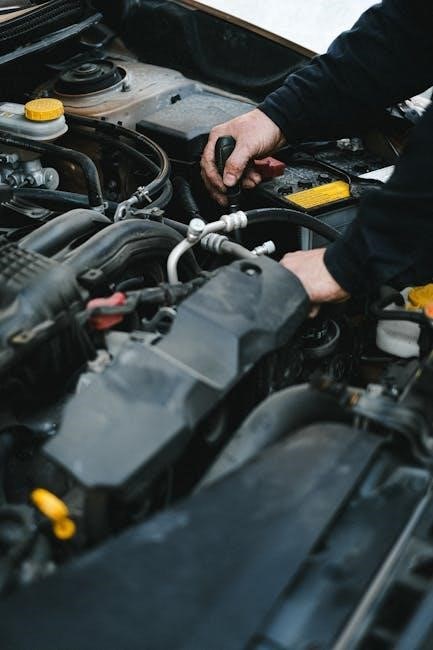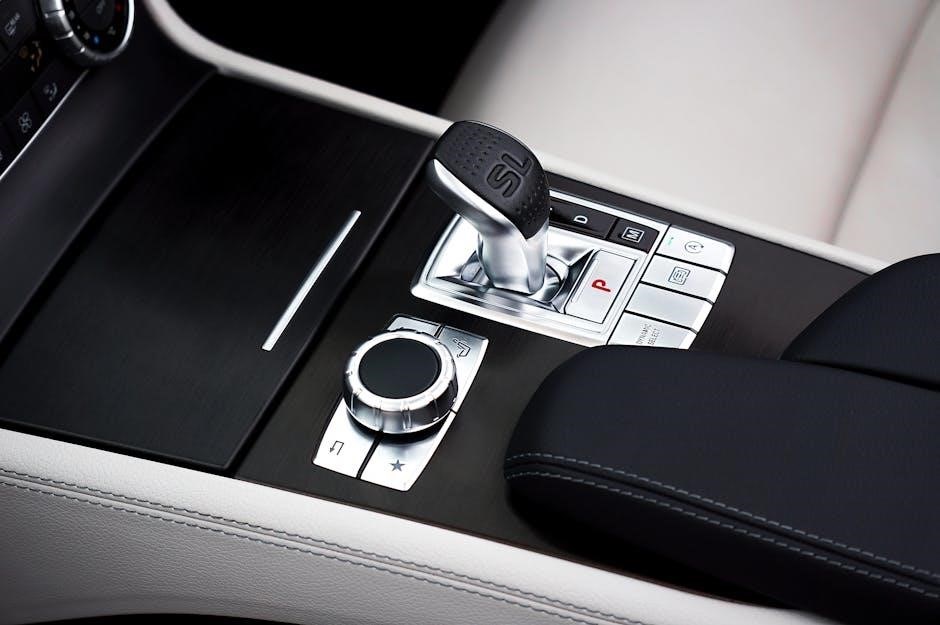The debate over manual vs. automatic transmission safety in car accidents remains unresolved. While neither is definitively safer, driver behavior and regional habits significantly influence accident rates.
Overview of the Topic
The relationship between car accident rates and transmission types (manual vs. automatic) is complex and influenced by multiple factors. While neither transmission type is inherently safer, studies suggest that driver behavior, experience, and regional driving habits play significant roles. Manual transmissions are often associated with more accidents in certain regions, possibly due to the learning curve and driver inexperience. Automatic transmissions, while easier to operate, may lead to complacency. Ultimately, the data shows no clear winner, as safety depends on the driver’s ability to handle the vehicle effectively in various scenarios.
Importance of Understanding Transmission Types
Understanding the differences between manual and automatic transmissions is crucial for assessing accident risks. Manual transmissions require driver engagement, which may reduce distractions but increase errors for inexperienced drivers. Automatics, while simpler, can lead to complacency. Recognizing these dynamics helps drivers choose the right vehicle for their skills and habits, potentially lowering accident risks. This knowledge also aids policymakers in creating safer road environments and insurance companies in setting accurate premiums based on transmission type and driver behavior.
Objective of the Article
This article aims to provide a comprehensive analysis comparing car accident rates between manual and automatic transmissions. By examining statistics, driver behavior, and regional differences, it seeks to determine which type may be safer. The goal is to offer insights for drivers choosing a vehicle, policymakers improving road safety, and insurers assessing risks. Ultimately, it strives to clarify the debate and empower informed decisions based on data and expert opinions.

How Manual and Automatic Transmissions Work
Manual transmissions require driver interaction with a clutch and gearshift, while automatics use a torque converter and sensors to shift gears automatically, optimizing speed and torque seamlessly.
Manual Transmission: Mechanics and Driver Interaction
A manual transmission relies on the driver to operate a clutch pedal and gearshift, manually changing gears. The driver presses the clutch to disconnect the engine from the transmission, selects the desired gear, and releases the clutch smoothly to maintain control. This interaction demands attention and skill, as improper shifting can lead to reduced vehicle control, potentially contributing to accidents, especially in sudden stop situations or challenging driving conditions.
Automatic Transmission: Mechanics and Driver Interaction
An automatic transmission uses a torque converter and complex sensors to shift gears automatically, eliminating the need for manual clutch operation. This design allows drivers to focus solely on steering and braking, reducing the cognitive load and physical demands of driving. In emergency braking scenarios, automatics can downshift smoothly, maintaining vehicle stability and control, which may enhance safety compared to manual transmissions in situations requiring rapid driver response.
Key Differences in Driver Control
Manual transmissions require active driver engagement, with clutch and gearshift operation demanding attention and skill. This can lead to distractions or errors, especially for inexperienced drivers. Automatic transmissions, however, simplify driving by eliminating manual gear changes, allowing drivers to focus more on road awareness. While manuals offer precise control in specific conditions, automatics reduce driver workload, potentially lowering accident risks in dynamic situations. The trade-off lies in balancing control with convenience and situational demands.

Safety Comparison: Manual vs. Automatic
Research indicates neither manual nor automatic transmissions are definitively safer, as accident rates are heavily influenced by driver skill, behavior, and situational awareness.
Accident Statistics: Manual vs. Automatic
Studies show automatic transmissions are involved in more accidents due to their higher prevalence on the road. Manual transmissions, while less common, often have lower crash rates in certain scenarios. Regional differences play a role, with European data suggesting manuals cause more accidents, while U.S. trends lean the opposite. Ultimately, accident statistics are influenced by driver behavior, vehicle prevalence, and situational factors rather than transmission type alone.
Why Manual Transmissions Might Be Involved in More Accidents
Manual transmissions may be linked to higher accident rates due to the learning curve and driver inexperience. Stalling, improper gear shifting, and reduced focus on the road can increase crash risks, especially among novice drivers. Additionally, manual drivers often engage more with the vehicle, which can divert attention, leading to accidents in complex driving situations.
Why Automatic Transmissions Might Be Involved in More Accidents
Automatic transmissions are involved in more accidents due to their widespread use and driver complacency. Over-reliance on the vehicle’s automation can lead to reduced situational awareness, increasing crash risks. Additionally, automatics often dominate urban areas with heavy traffic, where frequent stops and starts heighten accident chances. Their ease of use may also attract less experienced drivers, contributing to higher accident rates compared to manual transmissions.
Role of Driver Behavior in Accident Rates
Driver behavior significantly impacts accident rates for both manual and automatic transmissions. Inattentive driving, speeding, and aggressive maneuvers increase crash risks regardless of transmission type. Manual drivers may face additional challenges due to the learning curve, while automatic drivers might become complacent, relying too heavily on the vehicle. Skilled, attentive drivers in either type tend to have lower accident rates, emphasizing the importance of driver engagement and responsible habits behind the wheel.

Driver Behavior and Accident Risk
Driver behavior heavily influences accident risk, with inattentive or aggressive driving increasing crash likelihood for both manual and automatic transmissions, regardless of their inherent safety differences.
Driver Skill Level and Transmission Type
Driver skill level significantly impacts accident risk, with manual transmissions requiring more expertise to operate safely. Experienced drivers may handle manuals more effectively, reducing crash likelihood, while less skilled drivers might struggle, increasing the risk of accidents. Automatics, being simpler to operate, may reduce errors caused by gear-shifting mistakes, particularly among novice drivers. Thus, the correlation between driver proficiency and transmission type plays a crucial role in determining accident rates.
Impact of Driving Habits on Accident Rates
Driving habits, such as aggressive acceleration or sudden gear changes, can increase accident risks, particularly with manual transmissions. Smooth, defensive driving practices tend to reduce crash likelihood, regardless of transmission type. Additionally, distracted driving and speeding are common factors in accidents, often exacerbated by transmission-related challenges. Therefore, consistent and cautious driving habits play a vital role in minimizing accident risks for both manual and automatic vehicles.
Learning Curve for Manual Transmissions
Mastering a manual transmission requires practice, as improper use can lead to stalling or loss of control, increasing accident risks. New drivers, especially, face a higher likelihood of crashes while learning. A study revealed that drivers unfamiliar with manual transmissions are more prone to accidents during the initial learning phase. Smooth clutch and gear engagement take time to perfect, emphasizing the importance of practice in reducing risks associated with manual transmission vehicles.

Crash Scenarios and Transmission Performance
Manual transmissions require driver engagement in sudden stops, while automatics shift seamlessly. Driver skill and behavior significantly influence vehicle control during emergencies, impacting crash outcomes.
Manual Transmissions in Sudden Stop Situations
Manual transmissions require drivers to actively downshift and brake smoothly during sudden stops. This can reduce skidding risks if executed properly. However, inexperienced drivers might stall the engine or mismanage gears, potentially causing loss of control. In emergency situations, the need for manual engagement can lead to slower reaction times compared to automatics, which shift automatically. Proper training and practice are crucial for safe handling of manual vehicles in abrupt stop scenarios.
Automatic Transmissions in Emergency Braking
Automatic transmissions excel in emergency braking by allowing drivers to focus solely on deceleration without manual gear shifts. This can reduce reaction times and maintain traction control, enhancing stability. Modern automatics often feature advanced systems that preemptively downshift during hard braking, improving stopping efficiency. Additionally, automatics eliminate the risk of stalling, which can occur with manuals during sudden stops, thereby reducing accident risks in critical situations.
Transmission Type and Vehicle Control During Accidents
Transmission type can influence vehicle control during accidents. Manuals require driver input to shift gears, potentially distracting from steering or braking. Automatics, however, allow drivers to focus solely on evasive maneuvers, maintaining better control. Automatics also reduce the risk of stalling, which could worsen a crash. Modern automatics often integrate with safety systems, optimizing deceleration and stability, whereas manuals rely heavily on driver skill. This difference can affect accident outcomes, highlighting the importance of driver adaptability and transmission system compatibility.

Demographic and Regional Differences
Transmission preferences and accident rates vary by region. European countries favor manuals, often reporting higher accident rates, while the U.S. prefers automatics, with lower accident rates.
Transmission Preferences in Different Countries
Countries like the UK and Germany predominantly use manual transmissions, while the U.S. favors automatics. In Japan and South Korea, automatics are more common, influenced by traffic conditions. Emerging markets often prefer manuals due to lower costs. These preferences impact accident rates, with Europe’s manual-heavy regions sometimes reporting higher accident rates compared to automatic-dominant areas. Driver behavior and regional driving habits also play a significant role in transmission-related safety trends globally.
Accident Rates Across Different Demographics
Younger drivers, particularly teenagers, are more likely to be involved in accidents, regardless of transmission type. This is often due to inexperience and risk-taking behavior. Urban areas tend to see higher accident rates for manual transmissions, possibly linked to frequent stop-and-go traffic, which can increase driver error. In contrast, older drivers may prefer automatics for ease of use, potentially reducing fatigue-related incidents. These demographic factors highlight how driver experience and transmission type intersect to influence road safety.
Regional Driving Habits and Accident Rates
Regional driving habits significantly impact accident rates for manual and automatic transmissions. In Europe, where manuals are prevalent, higher accident rates are observed, possibly due to the learning curve and driver inexperience. Conversely, in regions like North America, where automatics dominate, accident patterns differ, often linked to driver behavior rather than transmission type. Urban vs. rural settings also play a role, as stop-and-go traffic in cities may increase manual transmission accidents, while automatics may perform better in such conditions.

Vehicle Technology and Safety Features
Modern safety features like adaptive cruise control and emergency braking are often integrated into automatic transmissions, reducing accident risks. Manual transmissions lack these advancements, relying on driver skill.
Impact of Modern Safety Features on Accident Rates
Advanced driver-assistance systems (ADAS) significantly reduce accidents by automating critical functions like braking and gear shifting. Automatic transmissions often come equipped with these features, minimizing human error and enhancing safety. In contrast, manual transmissions rely heavily on driver skill and attention, making them more susceptible to accidents caused by fatigue or distraction. The integration of technology in automatic vehicles has proven to lower crash rates, particularly in emergency scenarios, where split-second decisions are crucial. This technological advantage underscores the importance of modern safety features in reducing overall accident rates.
Automatic Transmissions and Advanced Driver-Assistance Systems
Automatic transmissions are increasingly paired with advanced driver-assistance systems (ADAS), such as adaptive cruise control and automatic emergency braking. These technologies enhance safety by reducing driver error, especially in emergency situations. Unlike manual transmissions, which require constant driver interaction, automatics allow drivers to focus more on road awareness, thereby lowering accident risks. The seamless integration of ADAS with automatic transmissions creates a safer driving environment, particularly in high-stress scenarios like sudden stops or lane changes.
Manual Transmissions and Driver Engagement
Manual transmissions require active driver engagement, as they demand constant interaction with the clutch and gears. This engagement can heighten situational awareness and reflexes, potentially reducing accidents caused by driver distraction. However, the learning curve for mastering manual transmissions can lead to errors among inexperienced drivers, increasing crash risks. The hands-on nature of manual driving fosters a stronger connection between the driver and the vehicle, which may enhance safety in skilled hands but poses challenges for those still learning.

Insurance and Maintenance Costs
Insurance rates for manual and automatic vehicles vary based on accident frequency and repair costs. Manuals often have lower maintenance expenses, potentially reducing long-term insurance premiums.
Insurance Rates for Manual vs. Automatic Vehicles
Insurance rates for manual and automatic vehicles differ based on accident frequency, repair costs, and driver behavior. Automatics often face higher premiums due to increased accident involvement and costly repairs. Manuals, while cheaper to maintain, may see higher rates in regions with lower manual driver proficiency. Driver behavior significantly impacts premiums, as reckless driving raises costs for both transmissions. Insurers also consider vehicle type and regional driving habits when determining rates, making direct comparisons complex. Understanding these factors helps drivers make informed decisions.
Maintenance Costs and Their Impact on Safety
Maintenance costs vary between manual and automatic transmissions, affecting safety. Manuals typically have lower maintenance expenses, with fewer components needing replacement. Automatics, however, incur higher costs due to complex systems like torque converters and sensors. Neglecting regular maintenance can lead to mechanical failures, increasing accident risks. Proper upkeep ensures optimal performance, reducing the likelihood of breakdowns. Balancing maintenance costs with safety priorities is crucial for drivers to minimize risks and maintain vehicle reliability on the road.
Long-Term Ownership Costs and Accident Risk
Long-term ownership costs differ between manual and automatic transmissions, influencing accident risk. Manuals generally have lower repair and maintenance costs, reducing financial strain that might lead to neglected upkeep. Automatics, while more expensive, often integrate advanced safety features, enhancing accident prevention. Balancing these factors, drivers should consider both affordability and technology investment to minimize risks and ensure long-term safety on the road.

Real-World Data and Case Studies
Real-world data shows regional variations in accident rates, with manual transmissions often involved in more accidents in Europe, while automatics dominate in the U.S.
Analysis of National Accident Reports
National accident reports reveal regional patterns in crash rates between manual and automatic transmissions. Data shows manual transmissions are often linked to more accidents in Europe, while automatics dominate in the U.S. These reports highlight the influence of driver behavior, vehicle control, and road conditions. Expert opinions suggest that attentive drivers, regardless of transmission type, are less likely to be involved in accidents. The analysis underscores the importance of driver skill and habits in determining safety outcomes.
Case Studies of Manual vs. Automatic Accidents
Case studies examining manual and automatic accidents highlight specific scenarios where transmission type impacts safety. For instance, manual transmissions often fail in sudden stops, while automatics may lose control during emergency braking. These incidents emphasize how driver interaction with the vehicle plays a critical role. Expert analysis of such cases reveals that manual transmissions require more skill, increasing accident risk for inexperienced drivers, whereas automatics rely on technology to mitigate errors, potentially reducing crash severity in certain situations.
Expert Opinions on Transmission Safety
Experts agree that neither manual nor automatic transmissions are inherently safer, as safety largely depends on driver skill and behavior. Manual transmissions require more engagement, which can reduce distractions but may lead to errors for inexperienced drivers. Automatics, while easier to operate, rely on technology that can sometimes fail. Both types have unique risks, but modern safety features in automatics, such as adaptive cruise control, often reduce crash severity. Ultimately, driver training and awareness are more critical than transmission type in preventing accidents.
Research indicates that neither manual nor automatic transmissions are conclusively safer, as accident rates are heavily influenced by driver behavior, skill level, and regional driving habits. Automatic vehicles are involved in more accidents due to their higher prevalence on the road, while manual transmissions may see increased accidents due to the learning curve and driver inattention. Modern safety features in automatics often enhance accident outcomes, while manual transmissions promote driver engagement, potentially reducing distracted driving. Ultimately, no transmission type is inherently safer overall.
Recommendations for Choosing a Transmission Type
Choosing between manual and automatic transmissions should consider personal preference, driving habits, and regional conditions. For inexperienced drivers, automatics may reduce accident risks due to simplified operation. Manuals are ideal for those seeking greater control and engagement, provided they are comfortable with the learning curve. Additionally, drivers in heavy traffic may prefer automatics for convenience, while those in areas with steep terrain might benefit from manuals for better control. Prioritize safety features regardless of transmission type to enhance overall driving safety.
Future Trends in Transmission Technology
Advancements in transmission technology are reshaping the automotive industry. Automated manual transmissions (AMTs) and dual-clutch systems are becoming more prevalent, blending manual control with automatic convenience. Electric vehicles (EVs) often feature single-speed or multi-speed transmissions, prioritizing efficiency. Future trends may include hybrid systems that combine manual and automatic modes, offering drivers flexibility. These innovations aim to enhance safety, performance, and driver engagement, catering to diverse preferences while addressing accident risk factors.

Resources and Further Reading
- National Highway Traffic Safety Administration (NHTSA) reports on vehicle safety.
- Insurance Institute for Highway Safety (IIHS) studies on transmission types.
- Guides on manual and automatic driving techniques for accident prevention.
Recommended Studies and Research Papers
Key studies from the National Highway Traffic Safety Administration (NHTSA) and the Insurance Institute for Highway Safety (IIHS) provide insights into accident rates by transmission type. Research papers highlight regional differences, with European studies suggesting manual transmissions are involved in more accidents, while U.S. data shows automatics are more common in crashes due to their prevalence. These resources offer in-depth analysis of driver behavior, vehicle control, and safety trends, helping readers understand the complexities of transmission safety. Visit IIHS.org for detailed reports.
Guides for Safe Driving with Manual and Automatic Transmissions
Expert guides emphasize mastering clutch control for manual drivers to avoid stalling and losing vehicle control during emergencies. For automatics, smooth acceleration and proper use of brake systems are critical. Both transmission types benefit from defensive driving techniques, such as maintaining safe distances and minimizing distractions. Visit NHTSA.gov for comprehensive driving tips tailored to each transmission type, ensuring safer road practices and reduced accident risks for all drivers.
